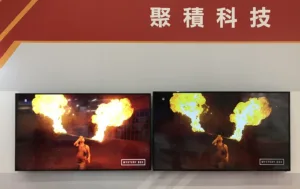Macroblock participates in Touch Taiwan Display International 2021; the booth is in the mini-/ micro-LED theme pavilion. The focus of this exhibition is the comparison between mini-LED backlight technology and traditional backlight technology.
We compare LCD TVs with 65 inches in size and play 4K quality videos at the same time. We can see the obvious difference between the two: the details in the dim picture are clearly distinguishable; the detailed textures can be seen in the bright pictures, and the vivid color of the display screen also greatly surpasses the one of traditional backlight technology. The reason for the aforementioned differences is that the light-emitting board under the display panel is composed of thousands of mini-LEDs. When a bright picture is displayed on a screen, the LEDs under the picture are lit up in different zones according to the brightness of the picture, and the brightness is at least 1,000 nits, much higher than the traditional backlight. In a dark picture, the brightness can be dimmed as low as 0, improving the apparent contrast ratio.
Therefore, the local dimming function of thousands of zones achieved by using mini-LED backlight technology can realize high dynamic contrast (HDR) and the independent dimming functions. The demonstrated mini-LED backlit TV is built with Macroblock’s LED driver ICs featuring 1,152 dimming zones, which can reach the HDR1000 (maximum brightness 1000 cd/m2) specification. Array Vision mini-LED boards are designed by the partner A2V team, with precise local dimming algorithm, Array Plus and Pixel Compensation Tech on TFT Panel, effectively reduce the common halo problem of mini-LED local dimming.
Macroblock has launched four mini-LED backlight driver ICs for different size applications. Common features include: 1) “Local dimming” design that can achieve HDR effects. 2) The number of driver ICs is reduced, which simplifies PCB design and board layers, reduces costs and PCB failures, improving the overall yield. 3) Insert the black screen function to reduce the blur phenomenon that occurs when the dynamic picture is displayed, and the black screen insertion function can be controlled flexibly.
In addition to exhibiting products in the theme hall, Macroblock’s chairman, Yang, Li-Chang, is also invited to participate in the “International Micro/ Mini LED Display Conference” and delivers “technical breakthroughs at all relevant aspects” with the topic of High Scan Technology Targeting to mini-/ micro-LED Direct View Display, including:
- Breakthrough in commercial direct view displays
- Substrate and possible pixel pitch
- The development history of highly integrated driver ICs: The progress from traditional scanning architecture to the scan sharing architecture, greatly reducing the number of driver ICs, and further developing to the multi-channel and high scan driving architecture to achieve more savings in driver ICs; the high scan technology bringing about four times the number of LEDs that can be driven by a single driver IC.
In addition, another focus of the speech focuses on “How can the high scan driving architecture satisfy the demand?” Macroblock’s driver IC responds to the current trend of virtual production and can support 120 frame rate* for the current shooting and broadcasting requirements.
Macroblock continues to be keenly aware of future market development trends to develop new products. Visitors are very surprised by the mini-LED backlight technology demonstrated in the exhibition. It is expected that the technology will enter a large-scale commercial stage soon. In the forum, it was mentioned that the Macroblock driver ICs can support higher scan numbers than existing products on the market, and meet the specifications of mini-/ micro-LED direct view display applications in all aspects.
*Video and animation special effects are composed of countless pictures, each picture is one frame; 120 frame rate refers to 120 pictures displayed per second, the higher the number of frames, the smoother and more realistic the picture audiences will see.

